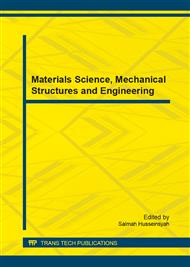p.379
p.383
p.387
p.391
p.395
p.399
p.403
p.410
p.414
The Life Prediction of Transmission Tower Based on Multi-Scale Analysis
Abstract:
In order to study the residual fatigue life of 500 kv transmission tower under load conditions, a multi-scale finite element model of transmission tower is established. By simulating time course of wind load, using Miner fatigue cumulative damage theory and linear S-N curve, the calculation method of transmission towers fatigue life is established. The research shows that the multi-scale model can better simulate the stress and strain state of the transmission tower, and can predict the remaining service life of the transmission tower .The research has important significance and application value for the safe operation of the transmission lines.
Info:
Periodical:
Pages:
395-398
Citation:
Online since:
October 2014
Authors:
Keywords:
Price:
Сopyright:
© 2014 Trans Tech Publications Ltd. All Rights Reserved
Share:
Citation:


